DENMARK
The
Royal Arms

|
|
|
|||
|
The Greater Royal Arms |
|||||||||||
|
|
|||||||||||
|
Valdemar IV Atterdag |
*1320-†1375 King of Denmark
1340-1375 Duke of Estonia
1344-1346 |
||||||||||
|
|
|||||||||||
|
House of Norway |
|||||||||||
|
|
|||||||||||
|
Oluf II (IV) |
*1370-†1387 King of Denmark
1376-1387 KIng of Norway
1381-1387 |
||||||||||
|
|
|||||||||||
|
Margarethe I |
*1353-†1412 Queen of Denmark 1387-1396 |
||||||||||
|
The use of more than one coat of arms corresponding with
the royal posessions was introduced by Margarethe I.
Seal of majesty of
Margarethe Petersen 53 The queen in majesty surrounded by the arms
(clockwise) of Norway, Denmark, Folkunge and Schleswig. L.: SECRETV
MARGARETE DI GRA NORVEGIE ET SVECIE REGINA D.:
!375-1376 |
|||||||||||
|
House
of Pomerania |
|||||||||||
|
|
|||||||||||
|
Erik VII of
Pomerania |
*1382-†1459 King of Norway 1389 King of Denmark and Sweden 1396-1439 |
||||||||||
|
Seal of Erik VII of Pomerania Petersen
61 Arms:
Quarterly: 1. Denmark; 2. Sweden; 3. Folkunge; 4. Pomerania; Over all a cross
charged with an escutcheon of Norway. L. S ERICI DEI GRA REGNORUM [DACIE SWECIE
NORWEGIE REGIS AC DUCIS POMERAN D.:
1398-1435
Arms of Erik
VII on a pew The arms
somewhat corrupted. In the third quarter the arms of Denmark repeated and in
the fourth the arms of Norway (From: Grandjean P. B.: 1926. Planche III).
Photo H.d.V. 1993 The ship flag preserved in the Marienkirche in
Lübeck, captured 1427, burned in WW II
(29.03.1942.) 19th cent. copy
in Slott Frederiksborg (DK) Original:
beginning 14th century Blasoning
of the flag: Quarterly:
1. Denmark; 2. Sweden; 3. Folkunge; 4. Pomerania. Over all a white cross. The mast side patch of the Virgin Mary with child
and St. James. |
|||||||||||
|
House
of the Palatinate |
|||||||||||
|
|
|||||||||||
|
Christoffer III |
*1416-†1448 King of Denmark 1440-1448 |
||||||||||
|
Secret
seal. Petersen
66 Arms: Quarterly:
1. Denmark; 2. Palatinate; 3. Wittelsbach; 4. Sclavonia. Over all a cross L. SECRETU
CRISTOFFERI DEI GRA DACIE SCLAVORU GOTORU Q REGIS COMITIS PALATINI RENI Z
DUCIS BAVAIE D. :
1440-1447
Ulrich Richental Konzil zu Konstanz Bayrische
Staatsbibliothek Rar 335 Arms: Quarterly:
1. Denmark; 2. Sweden; 3. Norway; 4. Sclavonia. Over all a cross Argent
rimmed Gules charged with an escutcheon quarterly of Palatinate and
Wittelsbach. Crown: Of
seven leaves Das durchleuchtig hochgeboren küng Cristoffel künig
zu Tennemarck zu schweden zu norwegen zu lauland vnd pfallencz graf bey rein
und herzog in bayerland
Seal of majesty of Christoffer II Petersen
67 Christoffer II in majesty between the arms of
Denmark and a quarterly of 1. A cross;
2. Palatinate; 3. Wittelsbach; 4. Pomerania. L.: SIGILLUM
MAIESTATIS CRISTOFORI D.G. DACIE SCLAVORU GOTORUM QE REGIS COMITIS PALATINI
RENI ET DUCIS BAVARIE D.: !441-1445
Heraldic
seal Petersen
68 Arms: Quarterly
ot Palatinate and Wittelsbach, a cross charged with an escutcheon quarterly
of Denmark, Sweden, Norway and Sclavonia.
L.: S. CRISTOFORIDACIE SVEDIE NORWEGIE XC REGIS COMITIS PALATINI
RENI ET DUCIS BAVARIE D.: 1444 |
|||||||||||
|
House of Oldenburg |
|||||||||||
|
|
|||||||||||
|
Christian I |
1448-1481 |
||||||||||
|
Christiern 1.s sigil som Konge al
Danmark, 1449. Skjoldholdere: to vildmamd. Denne og de følgende tre illustration er er taget Ira Henry Petersen: Danske kgl. Sigiller, 1917.
King
Christian I and his queen Painting in Slott Frederiksborg His coat of arms: Quarterly,
1. Denmark; 2. Sweden; 3. Norway; 4. Pomerania. Over all a cross Argent
rimmed Gules charged with an escutcheon: quarterly of Schleswig and Holstein
ensigned Oldenburg.
Secret seal of Christian I Petersen
79 Arms: Querterly: 1. Denmark;
2. Sweden; 3. Norway; 4. Quarterly of Schleswig and Holstein. Over alle a
cross charged with an escutcheon of Oldenburg. L.: SECRETU
CRISTIERNI REGIS D.: 1460-1480 |
|||||||||||
|
Hans |
1483-1513 |
||||||||||
|
Petersen
88 |
|||||||||||
|
Christian II |
*1481-†1559 1513-1523 164st knight of the Fleece. Barcelona 1519 King of Sweden 1520-1521 |
||||||||||
|
96-101
Petersen
98 Arms: Quarterly
1. Denmark; 2. Sweden; 3. Norway; 4 Wenden. Over all a cross rimmed charged
with a quarterly of 1&4: Schleswig, 2.Holstein, 3. Stormarn ensigned
Oldenburg L. :s cristiern DACIE
SVIE NORVIE SCLAVORV GOTORV REGIS DVCIS SLESVICEN D.: 1515-1519
His memorial table in St. Baafskathedraal Gent (B) Arms: Quarterly
1. Denmark; 2. Sweden; 3. Norway; 4 Wenden. Over all a cross rimmed charged
with a quarterly of 1&4: Schleswig, 2.Holstein, 3. Stormarn ensigned
Oldenburg Crown: A royal
crown Order: Of the
Fleece Så var det beskikket Thus
it was ordained |
|||||||||||
|
Frederick I |
1523-1533 |
||||||||||
|
on his seals 1524-1532 (Pet. n°s 110-113)
Great seal of Frederick I Petersen
113 Arms: The arms of
Oldenburg-Delmenhorst surrounded by (Clockwise): Denmark cross (crowned);
Norway, Wenden, Stormarn, Holstein, Schleswig, Denmark royal arms. L.: S FREDERICI DACIE NORWEGIA GOTTOR VAND REGIS SLESVICI HOSACIE ZC DVCIS
IN OLDEN ET DELMEN COMITIS
His arms on his portrait in Haderslevhus. Arms: 1. Denmark; 2. Norway; 3. King of
the Goths 4. King of the Wends; 5. Sweden; 6. Gotland; 7. Schleswig; 8
Island; 9. Holstein; 10. Stormarn; Delmenhorst. Over al a cross Argent rimmed
Gules, charged with an escutcheon Oldenburg Crown: A royal crown of five leaves 3
and 2. Mit håb er Gud alene My hope is God alone |
|||||||||||
|
Christian III |
1534-1559 |
||||||||||
|
Seal of
Christian III as an heir of Norway, Schlewig and Holstein Petersen
118 Arms: Quarterly:
1.Norway; 2. Holstein, 3. Schleswig; 4. Stormarn and a cross over al charged
with Oldenburg. Crests: Middle:
Norway; D.: Holstein. S.: Schleswig L. : CRISTIANVS - D
- G - HERES - REGNI - NORVEGIE - DVX.- SLESVICENSIS - ET - HOLSATIE - Z'. D.
1533-1536 After his
father's death, in 1533, Christian was proclaimed king at an
assembly in Rye, a town in eastern Jutland,
in 1534. The Rigsraad, dominated by Roman Catholic bishops and nobles,
refused to accept Duke Christian as king and turned to Count Christopher of Oldenburg in order to restore
Christian II to the Danish throne. Christian II had supported both the Roman
Catholics and Protestant Reformers at various times. In opposition to King
Christian III, Count Christopher was proclaimed regent at
the Ringsted Assembly (landsting),
and at the Skåne Assembly (landsting)
on St Liber's Hill (Sankt Libers hög) near Lund Cathedral.
This resulted in a two-year civil war, known as the Count's Feud (Grevens Fejde) from 1534–36, between Protestant and Catholic
forces Chistopher of
Oldenburg
Seal of count Christopher of Oldenburg, 1534 Petersen175 Arms: Quarterly of Oldenburg and Delmenhosrt Crest: Of Oldenburg and Delmenhorst (combined). L.: S. CHRISTOPHORI COMITIS OLDENBORGENSIS ET DELMENHORST D.: 1534
Christian
III and his coat of arms On his genealogical tree, Nyborg Castle
Heraldic seal of Christian III, 1556 Petersen 123 Arms: Quarterly:
1. Denmark; 2. Norway; 3. Sweden; 4. Goths. Over all a cross rimmed charged
with and escutcheon quarterly of Schleswig, Holstein, Stormarn and Oldenburg.
And a base of Wenden. Crown: Of
five leaves L.: REX
CHRISTIANVS 3 D.G. DANOR NORVAG VANDALO ET GOTTOR D.: 1556 |
|||||||||||
|
Ske Herrens vilje |
SPES MEA SOLUS DEUS Zu Gott mein Trost allein |
The
Lord's will be done |
|||||||||
|
Frederick II |
1559-1588 |
||||||||||
|
Coat of arms of Frederick II (Royal
Library Kopenhagen) The quarterings of the main shield are: Denmark,
Norway, Sweden (or the union), king of the Goths. And a cross Argent, rimmed
Gules, charged with an escutcheon quarterly of Schleswig, Holstein, Stormarn
and Ditmarschen; ensigned of a per pale of Oldenburg and Delmenhorst. And a
base of the king of the Wends. |
|||||||||||
|
Intet uden Gud |
DEUS REFUGIU ET FIDUSIA
MEA |
Nothing without God |
|||||||||
|
Christian IV |
1588-1648 |
||||||||||
|
Arms of Christian
IV, 1588 Arms: Quarterly:
1. Denmark; 2. Norway; 3. Sweden; 4. King of the Goths. Over all a cross
rimmed charged with and escutcheon quarterly of Schleswig, Holstein, Stormarn
and Oldenburg. And a base of Wenden. Crown: Of
five leaves and four fleurs de lis |
|||||||||||
|
Christian IV’s crown |
|||||||||||
|
Christian IV’s crown Pelican side (front) Christian
IV’s crown, made 1595-1596 by Dirich Fyring in Odense. Gold with
enamel, table-cut stones and pearls; total weight 2895 g. The figures
on the crown’s large points illustrate the virtues and powers of a
king. In the
front of the crown a pelican pecking its breast in order to feed its
offspring with his blood, symbolizing the need for every
king to sacrifice his own blood in order to protect his subjects, as well as
being a traditional representation of the devotion of Christs’ sacrificial
death.
Christian IV’s crown Fortitudo (right side)
Christian IV’s crown Justitia (left side) On the
right point Fortitudo riding a lion
and on the left point Justitia
with sword and balance, representing the kings’ martial skills
and his position as the supreme judge.
Christian IV’s crown Virgin side (back) At the
back of the crown the Virgin Mary and child representing the king as being
superior to the church, showing his love to God and his devotion to his
subjects. Inside
are the coats-of-arms of the royal provinces. The crown
was constructed deliberately open, in spite of this being out of fashion.
This is said to have been related to the crowns of the nordic
Kalmarunion, consisting of Sweden and Norway and headed by Denmark.
This deliberate choice then, was presumably meant to show
his more or less legitimate claim to a unified Scandinavia. The
crown was used for the last time at Frederik III’s coronation in 1648, when
he decided to have it modernized, though having financial problems. He even
had to redeem the crown from a banker in Hamburg, because Christian IV had it
pawned. |
|||||||||||
|
Fromhed styrker rigerne |
REGNA FIRMAT PIETAS |
Piety strengthens the
realms |
|||||||||
|
Frederick III |
1648-1670 |
||||||||||
|
Arms: Quarterly:
1. Denmark; 2. Norway; 3. Sweden; 4. Goths. Over all a cross rimmed charged with
and escutcheon quarterly of Schleswig, Holstein, Stormarn and Oldenburg. And
a base of Wenden. Crown: Of
five leaves |
|||||||||||
|
Herren være mit forsyn |
DOMINUS PROVIDEBIT |
The
Lord will be my guide |
|||||||||
|
Christian V |
1670-1699 |
||||||||||
|
|
|||||||||||
|
Christian Vs Crown and Mantle |
|||||||||||
|
The royal
crown, used by kings from Christian V to Christian VIII, was executed by Paul
Kurtz in Copenhagen 1670-71 (by others: between 1660 and ‘65) and is of a total weight of 2080 g. On the
crown are two sapphires and grenades, on top of the cross of the orb is a corundum (a sapphire with a strip of
ruby). The gems probably originate from older jewels: the sapphire on
the front of the diadem can be traced back to Frederick I. and was probably a
gift to his father, Christian I (1448-’81)., by the Duke of Milan, 1474. On
the palm leaf is a square stone whith
Christian V ‘s royal cypher.
Royal cypher of Christian V with his personal motto The royal
crown was last used by Christian VIII's anointing in 1840. After the adoption
of the constitution and the introduction of the constitutional monarchy in
1849, the regent is neither crowned nor anointed. However, the royal
crown is used at the death of the king, where it is laid on the coffin under
the castrum doloris (castle of
grief).
Royal Mantle used at the coronation of Christian V,
1671 Christian
VII couldn’t himself decide what to wear on his coronation in 1767. Since his
great-great-great-great grandfather Christian 4th’s coronation, it had become
a tradition that new kings wore a special, fine and expensive coronation
suit. It was made of white silk woven with gold, and cut to imitate the style
of a Spanish nobleman from the late 1500’s. At the coronation ceremony the
King put on the red velvet mantle
embroidered with gold, and lined with ermine, one of the most exclusive
royal symbols in all of Europe. The garments and mantle kept their
old-fashioned style, like the ceremony itself, for almost 300 years, right up
to the last Danish coronation in 1840. Coronations
are the most glorious ceremonies in the hierarchy of power. The clothes that
the King wore, in the time before television cameras, helped to make him
visible at a distance. The coronation robes are the manifestation of his
ascending the throne, with God’s benediction, and it had to be highly
visible, with sweeping lengths of silk velvet, glittering jewels, gold
brocaded fabrics, cascades of lace, and fluttering plumes. The garments were
heavy, expensive, uncomfortable and delicate, which forced the King to move
slowly and solemnly. A king’s
daily garments in 1767 mainly resembled the new, fashionable uniforms, so his
coronation garments – which he only wore that one day – looked very exotic.
His short, skirt-like breeches and the fitted doublet were just as peculiar
in 1767 as knee breeches and lace cravats would be for us today. |
|||||||||||
|
|
|||||||||||
|
By Christian V the shape of the cross was changed
from a straight rimmed cross into a cross moline Gules voided Argent.
Golden seal of Christian V Arms: Quarterly:
1. Denmark; 2. Norway; 3. Sweden; 4. Goths. And a base of Wenden. Over all a
cross moline voided charged with and escutcheon quarterly of Schleswig,
Holstein, Stormarn and Oldenburg.. Crown: Of
five leaves, five hoops and a cap L.: CHRISTIANVS D. G. REX DAN NOR VAN GOT DVX SLES HOL
ST DIT COM IN OLD ET DEL |
|||||||||||
|
Med fromhed og retfærdighed |
PIETATE ET IUSTITIA |
With piety and justice |
|||||||||
|
Frederick IV |
1699-1730 |
||||||||||
|
Royal arms in the Knight´s Hall of Rosenborg Castle,
Kopenhagen. 1709 Arms: ¼: 1. Denmark; 2. Norway; 3. Union
of Kalmar; 4. Goths; In base:. Wenden. Over all a cros moline Gules voided
charged with an escutcheon: ¼ 1. Schleswig; 2. Holstein; 3. Stormarn; 4.
Ditmarschen. In nombril point: 1|2 Oldenburg and Delmenhorst. Crown: The
danish royal crown Order: Danebrog-Ordenand the
Elefanten-Orden. |
|||||||||||
|
Herren være min hjælper |
DOMINUS MIHI ADIUTOR |
The
Lord be my aid |
|||||||||
|
Christian VI |
1730-1746 |
||||||||||
|
Photo H.d.V. 1981 Crowned royal arms with collars of the Danebrog-Orden and the Elefanten-Orden (Landesmuseum Oldenburg) |
|||||||||||
|
For Gud og folket |
DEO ET POPULO |
For
God and the people |
|||||||||
|
Frederick V |
1746-1766 |
||||||||||
|
|
|||||||||||
|
Med
klogskab og standhaftighed |
PRUDENTIA ET CONSTANTIA |
By prudence and steadfastness |
|||||||||
|
Christian VII |
1766-1808 |
||||||||||
|
Arms of Christian VII Front cover stamp of Grouber
de Groubentall, Marc Ferdinand: La Finance Politique, réduite en Principe et
en Pratique (1775) (Sfv.:3, 18 oktav). Arms: As for Frederick II |
|||||||||||
|
Fædrelandets kærlighed er min berømmelse |
GLORIA EX AMORE PATRIÆ |
The
love of the fatherland is my reward |
|||||||||
|
Frederick VI |
1808-1839 |
||||||||||
|
Royal Decree of 29 October 1819 [1]
The new royal seal of 29 october 1819
Arms of Frederick VI Adopted 29.10.1819 Arms 1819-1903. The quarter for Norway removed and
replaced by the arms of Schleswig. The third quarter per fess of The Union and
a per pale of Island
and a per fess of Faeröer and Grønland. The fourth quarter per fess of the
king of the Goths and the king of the Wends.
Arms of 1819 |
|||||||||||
|
Christian VIII |
1839-1848 |
||||||||||
|
|
|||||||||||
|
Frederick VII |
1848-1863 |
||||||||||
|
The
arms of 1819 surrounded by a garland of oak Folkets Kærlighed,
min Styrke |
|||||||||||
|
Line of Glücksburg |
|||||||||||
|
|
|||||||||||
|
Christian IX |
1863-1906 |
||||||||||
|
1903-1948.
This is the only version of the coat of arms in which Iceland is represented
by a falcon instead of the country's traditional stock fish.
1903-1948 From:
Meyers Großes Lexicon, 1905 Med Gud for Ære og
Ret |
|||||||||||
|
Frederick VIII |
1906-1912 |
||||||||||
|
Herren er min hjælper The
Lord is my aid |
|||||||||||
|
Christian X |
1912-1947 |
||||||||||
|
The pavillion omitted. The quarter for Island
changed by replacing the stockfish by the falcon of 05.08.1903. Min Gud, mit Land, min Ære |
|||||||||||
|
Frederick IX |
1947-1972 |
||||||||||
|
The
smaller arms surrounded by a garland
of oak. The quarter for Island removed. Med Gud for Danmark- |
|||||||||||
|
Margaret II |
1972- |
||||||||||
|
Arms:
Quarterly of 1& 4. Denmark, 2. Schleswig, Per fess of The Union and a per
pale of Faeröer and Grønland. Over all a cross Argent rimmed Gules charged
with an escutcheon of Oldenburg Crown: The
Crown of Denmark Orders: Of the
Dannebrog and of the Elephant Motto: Guds hjælp, folkets kærlighed, Danmarks
styrke Æ See illustration in the head of
this article The Royal
Coat of Arms may be shown without the supporters and the pavilion. The
crowned Coat of Arms encircled by the collars of the orders of chivalry is
thus seen on HM The Queen’s shield in The Chapel of the Orders at
Frederiksborg Palace, as well as in the Great Seal used for Royal
Appointments and laws enacted by Parliament. The Royal
Coat of Arms is reserved for the Monarch, the Royal House and the Royal
Household. |
|||||||||||
|
|
|||||||||||

© Hubert de Vries














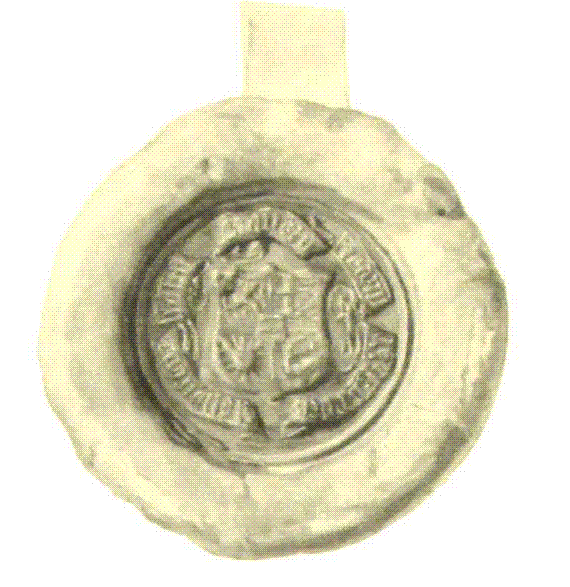















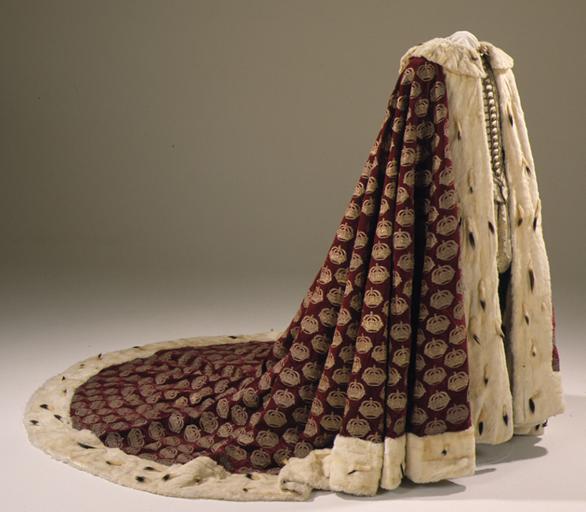
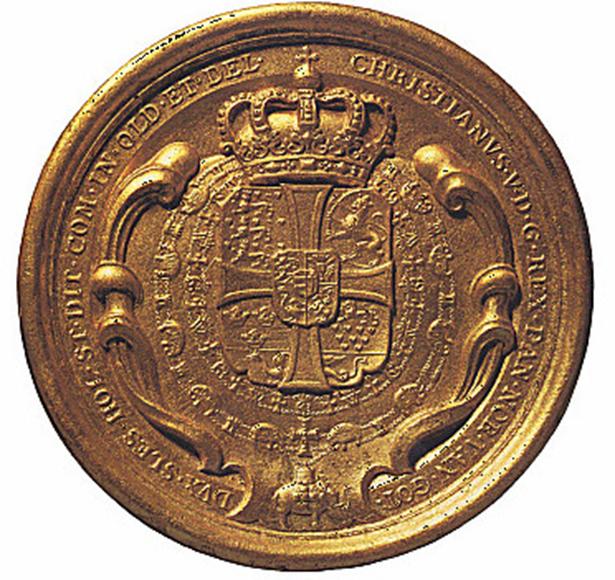
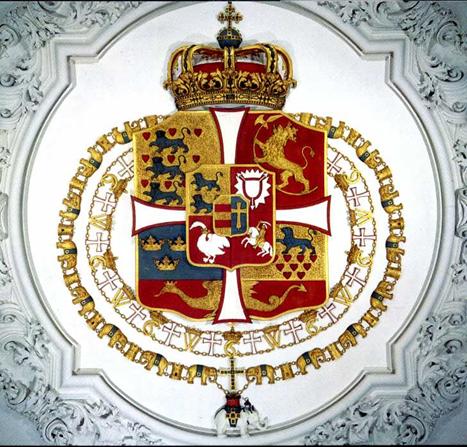
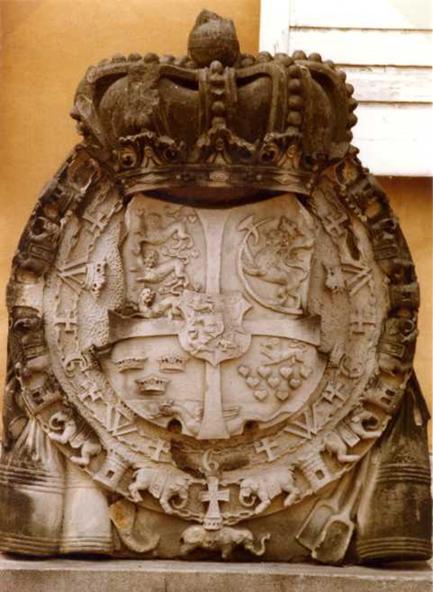
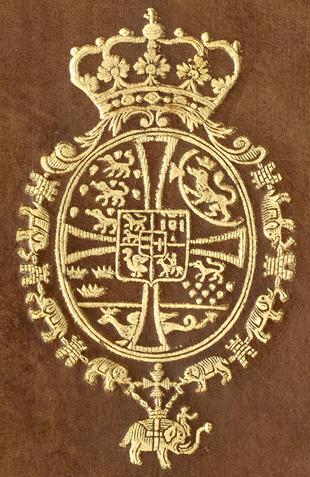
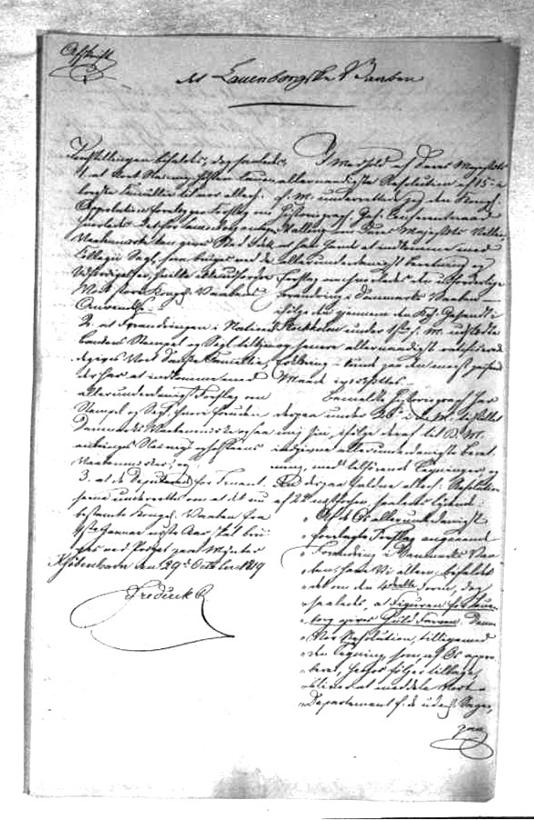

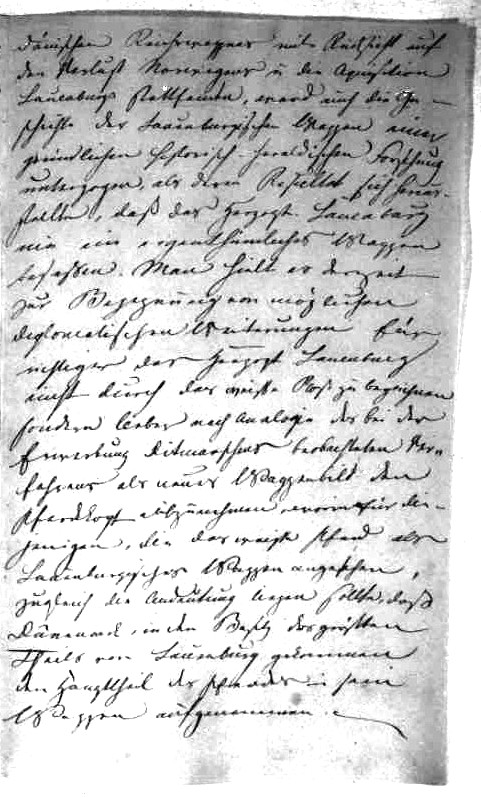
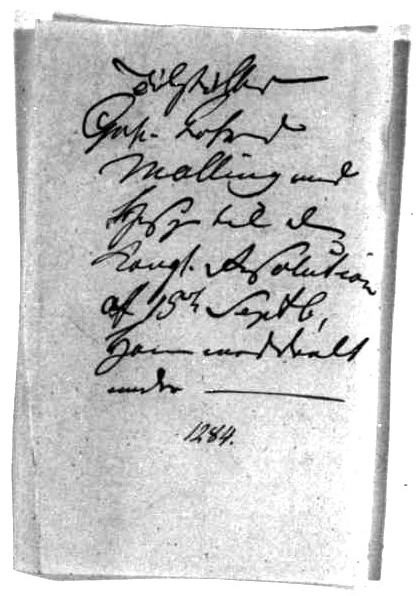
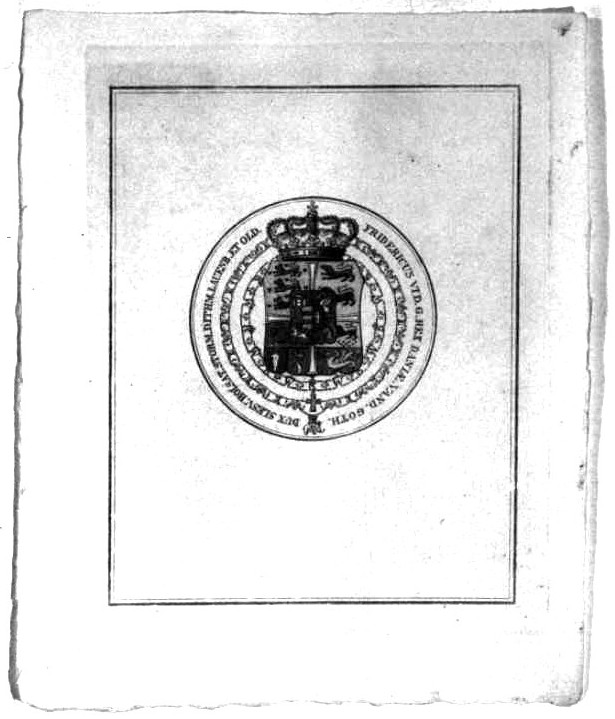
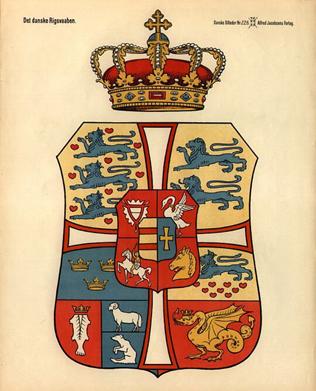

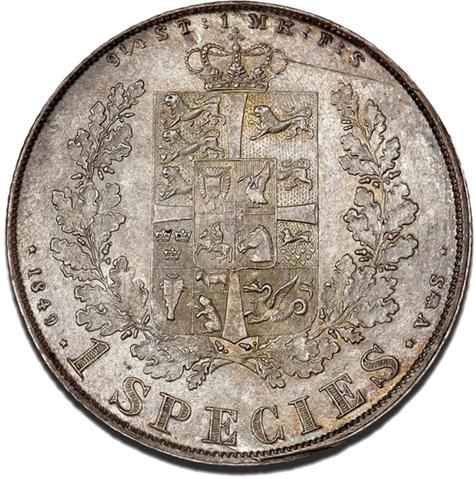
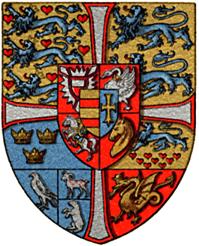
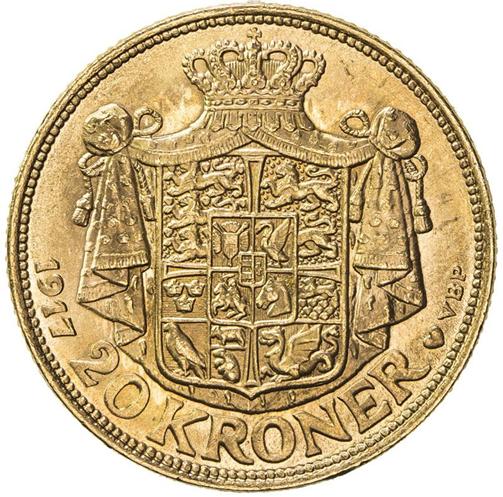
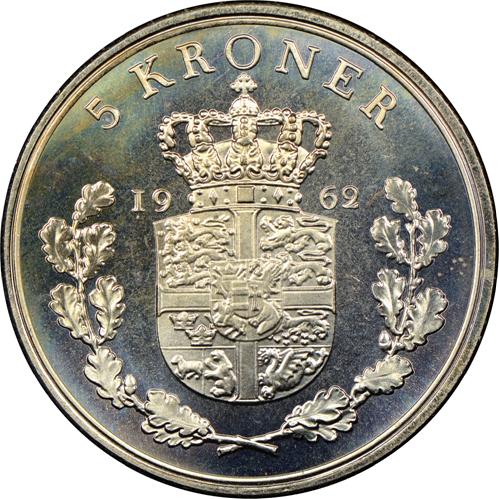
 Heraldry of the World
Heraldry of the World